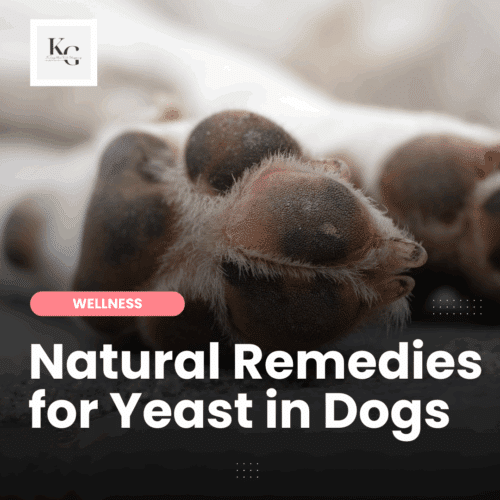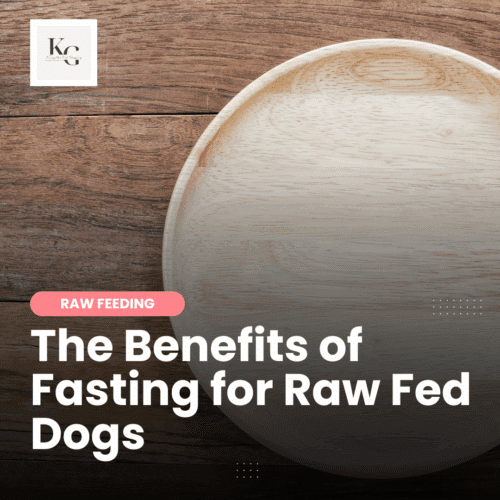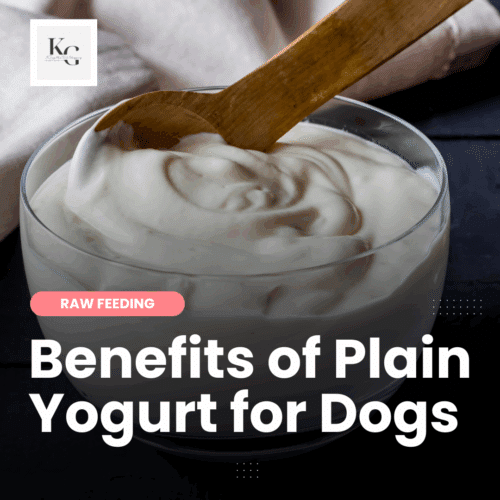Keep the Tail Wagging is supported by pet parents. I occasionally earn a commission (at no additional cost to you) when you click through an affiliate link to one of my favorite products. Thank you for your support. Read More
I transitioned my dogs to Darwin's Natural Pet Products, a local raw food company that ships nationwide. I could alternate between four proteins (beef, duck, chicken, and turkey), and my dogs did great on each one. Eventually, feeding commercial raw became too expensive, and I began DIY. The problem was that I was sourcing my meat from the grocery store, and I was only buying the following:
- chicken (quarters, thighs, legs, and wings)
- chicken liver
- chicken gizzards
- chicken hearts (sometimes)
When chicken would go on sale, I would fill a cart and walk out the door after having spent $100 on nearly 100 pounds of food. The problem was…
- I wasn't feeding a balanced raw diet to my dogs.
- My dogs had chicken sensitivities, so this diet didn't last long.
Why I Rotate Proteins in My Dogs' Raw Diet
Rotating proteins in a dog's diet is essential for several reasons:
- Nutritional balance: Each type of protein has different amino acid and nutrient profiles, and rotating proteins can help ensure a dog gets a balanced and varied diet to meet their nutritional needs.
- Preventing sensitivities: A dog can develop allergies to certain proteins if they're fed the same protein source over an extended period. Rotating proteins can help prevent this by exposing the dog to different protein sources.
- Palatability: Dogs may get bored or fussy repeatedly eating the same protein source. By rotating protein, it can increase the variety in the dog's diet and keep mealtimes interesting and exciting.
- Supporting gut health: A high-quality, balanced diet, including rotating protein sources, can help support gut health and prevent digestive issues.
- Keeps costs low: Some proteins are more expensive than others, and by rotating proteins, we can keep our budget in check over time.
By rotating proteins in my dogs' diet, I've seen which proteins they like quickly and do well on and which aren't a good fit. And I can adjust their diet quickly if a protein source is low on supply or no longer available.
I haven't noticed any negatives to alternating proteins other than the occasional temptation to try a protein that isn't in my budget. I can only feed rabbit, venison, and emu occasionally because these proteins are outside my budget.
Proteins I Feed to My Raw Fed Dogs
After I discovered a local raw food co-op, I went protein crazy, feeding anything I could afford (and a few proteins I couldn't afford). Today, I rotate five proteins in my dog's diet, including both red and white meat:
- duck
- quail
- pork
- grass-fed beef
- chicken
I feed proteins from local farms and trusted sources, choosing proteins my dogs can eat without issue. I no longer source proteins from the grocery store unless I plan to cook them or make dog treats.
Sardines, salmon, chicken eggs, and green tripe are proteins I add to the bowl, but I don't use these as the foundation of my meal preps. They offer important nutrients as side dishes.
Red Meat vs. White Meat
The primary difference between red meat and white meat is the type of muscle fiber and myoglobin content. Red meat comes from animals with more active muscles, such as cows, pigs, and sheep. The darker color of red meat is due to the high levels of myoglobin, a protein that stores oxygen in the muscles. The high myoglobin content in the muscles leads to more oxygenated muscles, which are darker in color.
On the other hand, white meat comes from animals with less active muscles, such as chicken and turkey. It contains less myoglobin than red meat, resulting in a lighter color.
Regarding nutritional content, red meat is typically higher in fat and calories than white meat, but it also provides more iron, zinc, and vitamin B-12. White meat is leaner and lower in calories but still contains high-quality protein and important nutrients like niacin, vitamin B-6, and selenium.
Overall, red and white meats can be a healthy part of a balanced diet in moderation. However, it is essential to choose lean cuts of red meat and consume it in moderation due to its higher-fat content.
Food Energetics
I prefer to feed cooling and neutral proteins to my dogs because, according to Traditional Chinese Medicine, these proteins won't cause inflammation, making them a great option for dogs with allergies, joint issues, and other inflammatory conditions.
- duck – cooling
- quail – neutral
- pork – neutral
- grass-fed beef – neutral
- chicken – warming
I also mix cooling proteins with warming and hot proteins to reduce the temp energetically. For example, I'll mix duck with venison, lamb, or emu.
How Many Proteins Should Dog Owners Feed?
The answer is, “It depends.” How many proteins you add to your dog's diet depends on your dog's tolerance, budget, and sourcing. I feed five proteins, but I'd be happy to feed three as long as they are ruminating and non-ruminating animals, red and white meat, and won't break the bank.







These fascinating insights into how mixing up protein sources can support optimal canine nutrition. From boosting nutrient intake to reducing the risk of allergies, the benefits are impressive and very helpful.
It’s a real eye-opener on why giving your furry friend a variety of protein sources is so important. The way you explained how it can enhance their nutrient intake, support healthy digestion, and even prevent picky eating habits. If you’re passionate about providing your dog with the best nutrition possible, this post is a must-read.
I agree that rotating proteins is essential. And not just proteins, but veg and supplements as well, which is something I know you practice as well. I tend to feed higher fat diets (keeping range about 1:1 P:F as my dogs do well on this. I always have pastured pork fat from White Oak on hand incase I need more (like with Venison or Veal).
Generally, I mix a high fat protein with a lower fat protein (like goat with turkey, lamb with chicken, pork with veal etc). I like to keep things simple with “extras” so I do egg on MWF and fish (3-4 oz) on TRS and Sunday is reserved for a raw goat milk or raw fermented goat milk fast, but only at about half their daily calories). I also feed a greater quantity of organ than the typical 5-5).
The only synthetic nutritional supplement that I add is zinc (no oysters here) and iodine (liquid drops, not kelp-that is a no go as well). These are added most days, but not every day all the time and U is a supp free day, though sometimes I will add an extra egg.
I only feed once per day and the protein mixes are usually 3-4 days worth before moving to the next mix.
As for the chicken, even though I buy pastured hens from a local farm, I always soak them (whole) in a bucket of white vinegar and water for about 20 minutes before processing. I dont measure but I would say this is about 25%+ vinegar. Seems to me all the bacteria would be on the outside, so I figure I am killing it that way.
As we all know, different proteins and even different cuts of the same animal, all have different nutrient profiles so mixing it up is just good insurance we are supplying a broad range. i like the way Dr. Conor Brady puts it (paraphrasing) “the body will reach equilibrium. It has to. Nutrients are not supplied equally in nature”.
I shop from my pet carnivore but their ground food is making my dogs itch now. I was feeding them goat, mutton, beaver, muskrat, turkey and rabbit. I could not feed duck because my dogs itched less than 24 hours after eating it. Then suddenly the turkey, mutton, goat and rabbit started making my dogs itch. I made sure it was that by feeding it only and then stopping it.
Grassfed beef is hard to find here and pork it out with the way they handle it processing it. So it is hard to feed any proteins.
Hi Kimberly. Your post was very helpful. I read the part when you talked about seeing all the posts/pictures of the raw food other raw feeders are feeding their dogs and not to push things fast. That’s so me right now. Just started my dogs on raw and I see all the pictures and I think man my dogs have to eat like that too and I pushed it too fast. My 3 dogs have upset tummies now because I just jumped right in. I may have to try Darwin’s Pet Food and just slow down while my dogs GI systems get use to the raw. Thanks again for this information it really helped!
Ahhh you’re amazing. Thank you!
Hi Frances…
Yes, that’s perfect because you’re feeding two balanced meals. The THK protein formulas meet your dogs’ nutritional needs as does Steve’s Real Food. Thanks for asking. I totally get the budget restraints. Costs can add up.
Hi Kimberly, I read your newsletter a lot and I really enjoy them. I was searching the web for a question I have but I can’t find the answer to my question anywhere. I wondered if you would know. I feed raw but I add it to The Honest Kitchen. I LOVE The Honest Kitchen by the way. Is it ok to feed THK (let’s say fish formula) during the day and at night just do raw instead of mixing them together? I feed Steve’s Real Food Raw. I am asking for cost purposes as you know feeding 2 dogs these foods is expensive. One of my dogs is a small breed, 5 months old. Thank you.
That’s a great question, Liz
I have reservation about feeding raw chicken because I’ve been told by people who process chicken that the bacteria levels are higher in that protein. I don’t know if this is correct or not, but my dogs have always done poorly on this protein so if I feed it raw, I only buy it from Answers Pet Food. They ferment all of their food and something about that process makes it better for my dogs. Otherwise, I cook chicken. I also cook some fish – so seafood like salmon, oysters, and mussels – I give to my dogs cooked. I feed my dogs sardines, mackerel, and carp raw because I trust my source. Duck, I feed raw, because, again, I trust my source – my dogs do great on it!
I have been feeding my Aussie Volhard Nutrition for the last 6 months but I almost always use ground beef as the protein. Now I realize that I probably should be switching it up. Is it OK to feed raw chicken duck and fish? Or should I be cooking it
I haven’t tried to rotate proteins yet. I wanted to wait until we were completely out of detox hell LOL
I have them on beef now and I want to switch to venison or lamb.
Great article.
Amy – I love peanuts too. Only the ones in the shell. I would eat them every day if possible but I’m afraid that I’ll develop an allergy, so I only buy two bags a month. I eat a strange diet.
Awesome post Kimberly!
Yes no doubt feeding Raw (and a rotational protein diet) is the best food to feed!
But just feeding Raw to having a healthy dog or cat is only half of the battle.
Other things such as:
Not Over-vaccinating.
Not using topical and internal pesticides for fleas, ticks and heartworms.
The over use of antibiotics which disrupts good Gut bacteria.
Giving Filtered water
Having a Holistic/Integrative Vet!
I’m honestly a little scared… I eat peanuts almost every day (and I lots of them). I absolutely love them and the thought that they could turn on me isn’t fun. I know the foods that we typically eat tend to be the ones that we develop a sensitivity to but I’m sticking my head in the sand and I’m keeping my fingers crossed (at least with regard to my health).
We rotate our girl’s protein source (and veggies) every meal. For instance, she’ll get chicken (backs, gizzards, livers, hearts, etc) for breakfast, beef (with all it’s extras) for supper, turkey (with it’s extras) for breakfast the next morning, pork (and extras) for supper and then back to the chicken the following day. She gets some supplements on some days/meals and not on others. Some meals she gets sardines added, some she gets raw eggs added, and then some days/meals she doesn’t get anything added … those are sad days 😀
I’ve learned so much from Kimberly but I think the most important thing I’ve learned is the balance over time aspect.
Rotating proteins is so so important! Great post–thanks for talking about the importance of protein rotation and giving some great tips about how to do it!
Terrific post! I had the same experience with peanuts, Kimberly. I ate them as a snack for about a month and all of a sudden my stomach got very sad every time I ate some. No more peanuts for me. :(. As this relates to your question in #3, our Sulley (mastiff) was raw fed for two years with about 60-70% of his diet being chicken. He started to develop constant ear infections due to a new chicken allergy. One thing I have noticed recently is as I am trying to move both of my mastiffs back to raw, Sulley is able to tolerate small amounts of chicken with, so far, no ear issues. I wonder if this is as much an issue with balance and variety as it is the amount of any one protein. ?? What do you think?